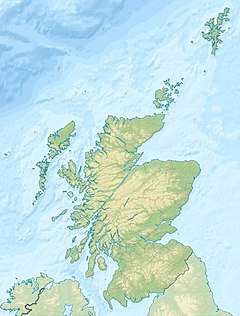| Cairnpapple Hill | |
|---|---|
 Burial mound on Cairnpapple Hill | |
| Highest point | |
| Elevation | 312 m (1,024 ft) |
| Prominence | c. 173 metres (568 ft) |
| Coordinates | 55°55′41″N 3°37′21″W / 55.92806°N 3.62250°W |
| Geography | |
Cairnpapple Hill in Scotland Cairnpapple Hill in West Lothian | |
| Location | West Lothian, Scotland |
| OS grid | NS987718 |
| Topo map | OS Landranger 65 |
Cairnpapple Hill is a hill with a dominating position in central lowland Scotland with views from coast to coast. It was used and re-used as a major ritual site for around 4000 years, and in its day would have been comparable to better known sites like the Standing Stones of Stenness. The summit lies 312 m above sea level, and is about 2 miles (3 km) north of Bathgate. In the 19th century the site was completely concealed by trees, then in 1947–1948 excavations by Stuart Piggott found a series of ritual monuments from successive prehistoric periods. In 1998, Gordon Barclay[1] re-interpreted the site for Historic Scotland. It is designated a scheduled ancient monument.[2]
- ^ Gordon Barclay, "Cairnpapple Revisited: 1948-1998", in Proceedings of the Prehistoric Society Vol.65, 1999, pp.17-46.
- ^ Historic Environment Scotland. "Cairnpapple Hill, prehistoric ceremonial complex (SM90053)". Retrieved 15 February 2019.

